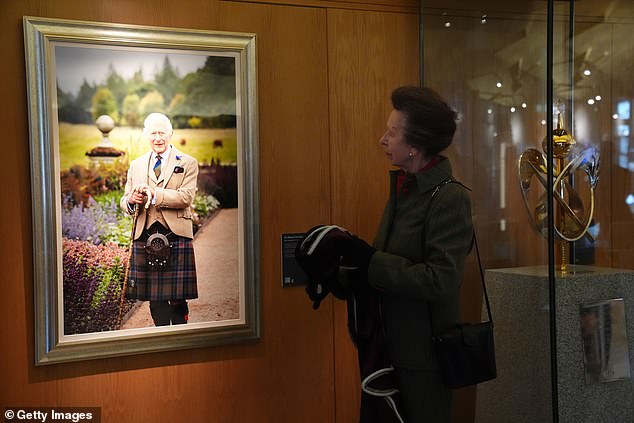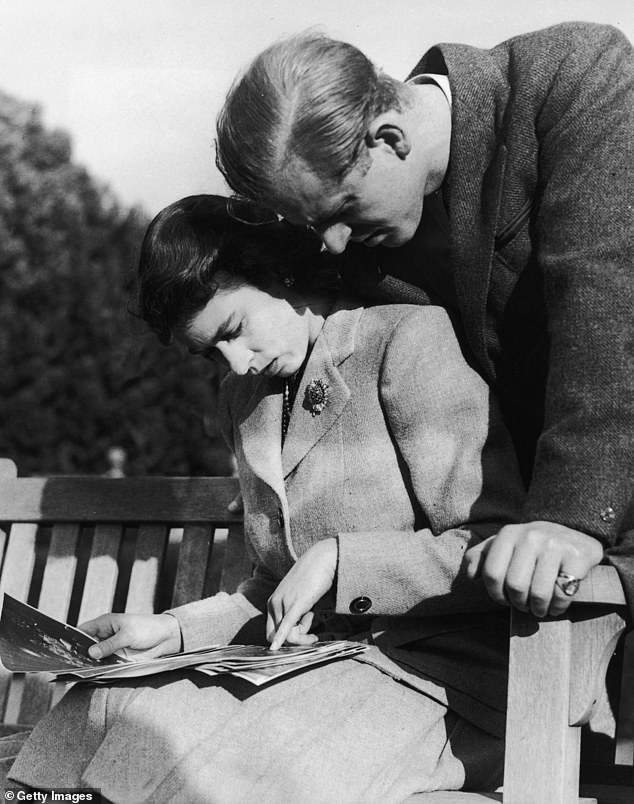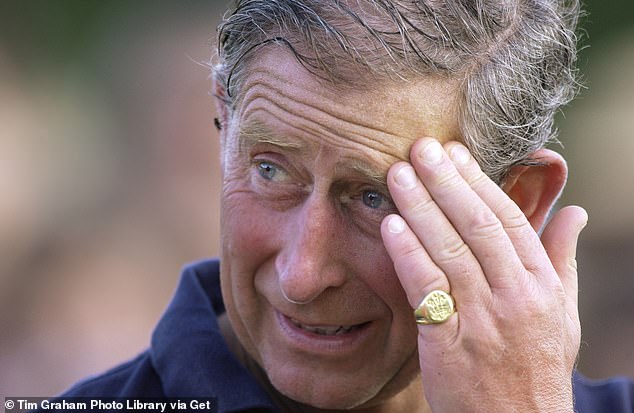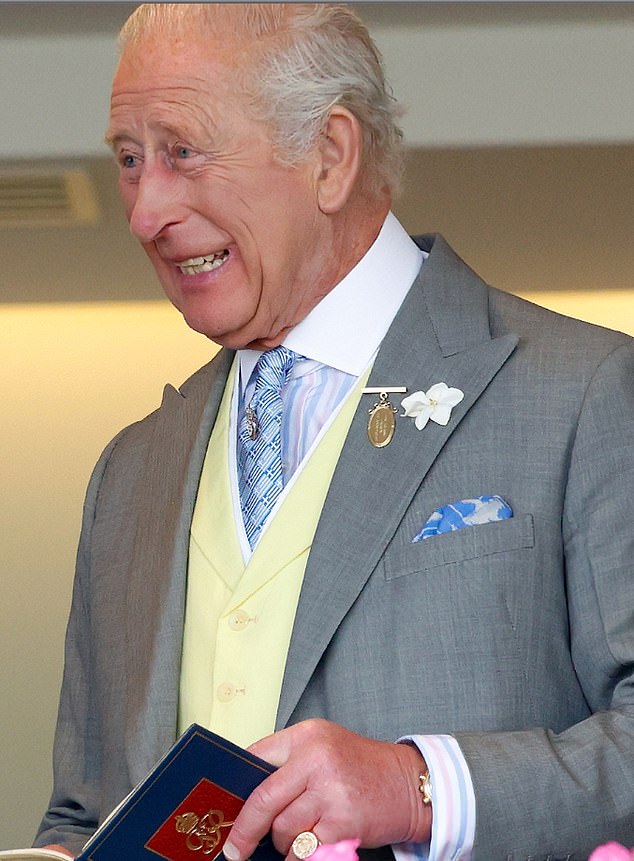Eagled-eyed fans have noticed that His Majesty the King is wearing a new, or rather different, signet ring in his portrait at the Scottish Parliament, which was unveiled last week by his sister, the Princess Royal. A ring with a most sentimental meaning attached to it.
King Charles has, for decades, worn a yellow gold oval shaped signet ring engraved with the coronet and plume, traditionally, of the Prince of Wales, which was presented to him by his mother not long after his investiture in 1969.
It is believed to have been a gift from his great uncle Prince Edward, who had been the Prince of Wales when he met divorcée (and married) Wallis Simpson, before ascending the throne, as Edward VIII and abdicating in 1936, and becoming the Duke of Windsor.
As Prince of Wales, Charles took his role very seriously, so the ring with its motto of ‘Ich Dien’ (German for ‘I serve’) inscribed on a ribbon would have been very significant.
Often believed to be the official plume of the Prince of Wales, the three ostrich feathers are in fact the motif of the heir to the throne (so the late Queen would have been entitled to wear them) and can be traced back to the Black Prince (whose garnet – albeit entitled Ruby is set in the Imperial State Crown), heir apparent to Edward III, who had three ostrich feathers on his shield.
His mother, Queen Philippa is thought to have brought the three ostrich feather insignia with her, as it is the badge of her family the House of Hainault, and the motto ‘Ich Dien’ is in her mother tongue.
However, it wasn’t until the early sixteenth century that it became associated with the Prince of Wales, thanks to Henry VIII’s elder brother – Arthur, who died aged 15 years old.

Princess Anne unveils a new portrait of King Charles III, taken by photographer Millie Pilkington, during a visit to the Scottish Parliament Building, Holyrood, September 2025

Prince Philip is seen, wearing his signet ring with his wedding ring whilst on honeymoon at Broadlands, 1947
But back to the King’s new ring which now has no doubt even more meaning to him than that of his great uncle.
It is believed that this ring belonged to his father Prince Philip, the Duke of Edinburgh who died in April 2021, as the ‘new ring’s’ coat of arms is that of the Greek Royal Family, of which Prince Philip was a member.
Photographs of Prince Philip as a young man show him wearing a ring, with the arms of a Greek prince, that is thought to have been inherited from his father, Prince Andrew of Greece and Denmark, who died in Monte Carlo in 1944 – Prince Philip went to Monaco to retrieve this and other belongings after the war.
The ring was purportedly made by Philip Antrobus, who also made Her late Majesty’s engagement ring with diamonds from a tiara that had belonged to Prince Philip’s mother. Charlie Pragnell, a director of his family’s jewellery firm Pragnell which incorporated Antrobus Ltd several decades ago, told me ‘it’s wonderful how jewellery passes from one generation the the next as it embodies so many fond memories and emotions’.
While Justin Daughters, MD of antique jeweller Berganza, says that if this is indeed Prince Philip’s signet ring and thus a royal heirloom, “it carries an historical and emotional weight that cannot be measured on the open market. It would be a deeply personal and meaningful gesture, not just about the monarchy’s continuity, but a clear tribute to his father.”
Royal signet rings date back to Ancient Egypt when rings with seals were worn by the Pharaohs to seal scrolls and denote their position.
During the Middle Ages, Edward II permitted the use of his signet ring to seal official documents: signet rings represented the power of the monarch and were often passed on to the next king, or queen, symbolising the transfer of rule.
However later, signet rings belonging to royalty and the nobility were usually destroyed on the death of their owner to avoid forgery and impersonators.

King Charles has, for decades, worn a yellow gold oval shaped signet ring engraved with the coronet and plume, traditionally, of the Prince of Wales, that was presented to him by his mother not long after his investiture in 1969

It is believed that this ring belonged to his father Prince Philip, the Duke of Edinburgh who died in April 2021, as “new ring’s” coat of arms is that of the Greek Royal Family, of which Prince Philip was a part
It is believed that this ring belonged to his father Prince Philip, the Duke of Edinburgh who died in April 2021, as the ‘new ring’s’ coat of arms is that of the Greek Royal Family, of which Prince Philip was a member.
Signet rings can also be set with hardstones or indeed precious stones, which are engraved with the insignia or coat of arms of the holder. In the 16th century Spanish monarch and Holy Roman Emperor, Charles I of Spain had his coat of arms engraved into a diamond and set into a gold ring, by the Milanese sculptor and court jeweller Jacopo da Trezzo. The French princess and queen consort of Charles I, Henrietta Maria, had a large round cut diamond engraved with her coat of arms.
Queen Victoria and Prince Albert’s sons are thought to have brought the German tradition to England, of wearing wedding bands beneath their signet rings on the fifth finger of the left hand – a custom copied by many royal men today including King Charles III.
Prince William does not wear a wedding band (unlike his brother Prince Harry) and shortly before his 2011 wedding to the now Princess of Wales, a palace spokesperson said “There is only going to be one ring, in accordance with the couple’s wishes.”
Will he now wear ‘the Prince of Wales signet ring’, his own father’s previous one? We can only wait and see – but I wouldn’t hold your breath!